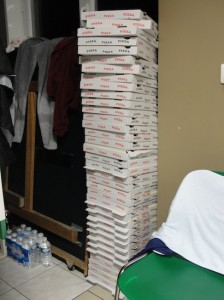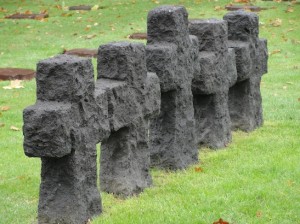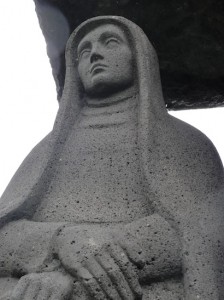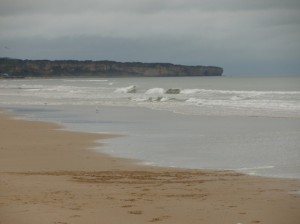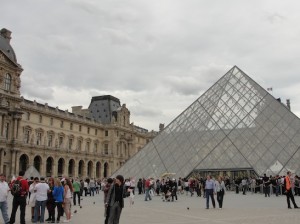This weekend was the Junior Class trip to Normandy. It was a trip full of history & fun and lacking in sleep & showers.
We left Thursday evening, drove through the night, and arrived in Normandy on Friday morning. Imagine trying to sleep on a stuffy bus with a bunch of excited teenagers!
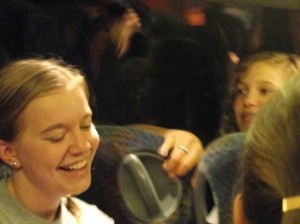 We had breakfast at a rest stop on the way.
We had breakfast at a rest stop on the way.
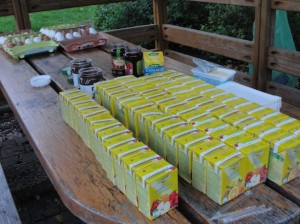 There were 5 beaches invaded on D-Day (June 6, 1944): Utah (invaded by US troops), Omaha (US), Gold (British), Juno (Canadian), and Sword (British).
There were 5 beaches invaded on D-Day (June 6, 1944): Utah (invaded by US troops), Omaha (US), Gold (British), Juno (Canadian), and Sword (British).
Our first stop in Normandy was the Canadian cemetery from World War I. The cemetery had a very personal feel to it; families of the soldiers put a meaningful quote on the gravestones. Some of them were particularly moving. I couldn’t help but think that these could have been my brothers if I had lived during that time.
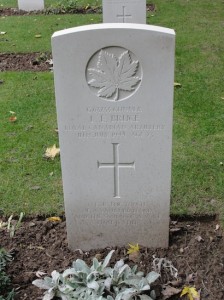 Then we drove to Juno Beach to learn a bit more about the role of the Canadians in the Normandy invasion.
Then we drove to Juno Beach to learn a bit more about the role of the Canadians in the Normandy invasion.
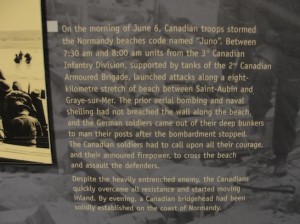 After lunch, we drove to Arromanches. The Allies created an artificial harbor here in order to supply the troops of the 5 beaches with supplies. It was fascinating to learn how they pulled floating roads across the English Channel and used a smoke screen to make the harbor in complete secrecy!
After lunch, we drove to Arromanches. The Allies created an artificial harbor here in order to supply the troops of the 5 beaches with supplies. It was fascinating to learn how they pulled floating roads across the English Channel and used a smoke screen to make the harbor in complete secrecy!
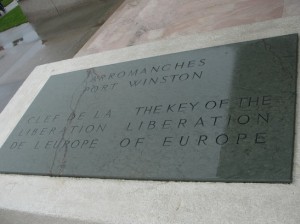 Next, we drove to a gun emplacement in Longues-sur-Mer, between the beaches Omaha and Gold. The heavy artillery here was part of Hitler’s “Atlantic Wall” protecting the coast from invasions. By creating the artificial harbors, the Allies snuck into the weak spots in the Atlantic Wall.
Next, we drove to a gun emplacement in Longues-sur-Mer, between the beaches Omaha and Gold. The heavy artillery here was part of Hitler’s “Atlantic Wall” protecting the coast from invasions. By creating the artificial harbors, the Allies snuck into the weak spots in the Atlantic Wall.
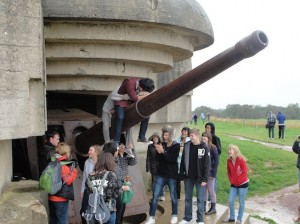 I’m sure the kids learned a lot from this trip, but they sure had fun too!
I’m sure the kids learned a lot from this trip, but they sure had fun too!
We finally made it to our campsite. We had the whole place to ourselves because it was closed for winter holidays. Some of the kids went and jumped in the ocean while the rest of us set up for dinner and played games. Unfortunately, there was no hot water. Some people took cold showers, but after lots of rain all day I didn’t feel much like taking one. Then we set up our sleeping bags and ate dinner (40 pizzas).
The entire group slept in one room in sleeping bags on the floor. I don’t know how we managed to fit 62 people into this place!
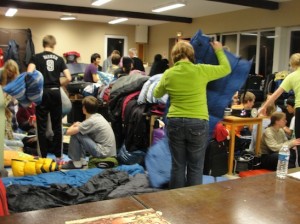 After watching film clips from Saving Private Ryan and Band of Brothers, we went to sleep – or at least, most of us went to sleep. Some of the other sponsors were awakened several times due to snoring, sleep talking, and kids getting up to go to the bathroom. I slept incredibly well that night (a solid 9 hours!), but only because of pure exhaustion.
After watching film clips from Saving Private Ryan and Band of Brothers, we went to sleep – or at least, most of us went to sleep. Some of the other sponsors were awakened several times due to snoring, sleep talking, and kids getting up to go to the bathroom. I slept incredibly well that night (a solid 9 hours!), but only because of pure exhaustion.
Saturday morning we woke up, ate breakfast, packed lunches, and went to the German cemetery.
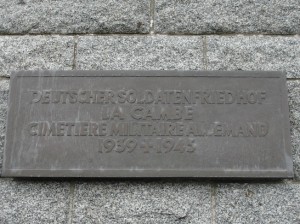 It had a very different feel than the Canadian cemetery. It was dark and somber, and less personal.
It had a very different feel than the Canadian cemetery. It was dark and somber, and less personal.
Next we went to the American cemetery.
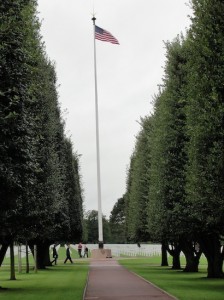 It reminded me of other American monuments & memorials, like the Arlington National Cemetery and the Lincoln Memorial.
It reminded me of other American monuments & memorials, like the Arlington National Cemetery and the Lincoln Memorial.
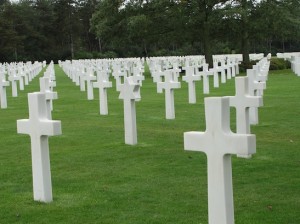 The American cemetery overlooks Omaha Beach (scene of Saving Private Ryan).
The American cemetery overlooks Omaha Beach (scene of Saving Private Ryan).
All the cemeteries had crosses; it’s the universal symbol for death. Yet each one reflected a different culturally appropriate way to grieve. The Canadian cemetery was very personal and preserved the memory of the individuals who died and the families they left behind; the German cemetery evoked a kind of reverent sadness and general darkness; the American cemetery honors the dead and reminds us that their deaths brought about a greater good. The Canadian cemetery made me want to cry for the lives lost; the German cemetery made me want to be silent and ponder heavy things; the American cemetery made me want to stand proud and shout about the triumph of those who fought and died.
Next, we drove to Pointe du Hoc, another German outpost in the Atlantic Wall. Located between Utah and Omaha beaches, the Germans had a prime location to shoot at both. The Americans scaled the cliffs at Pointe du Hoc early on D-Day in order to destroy the guns and make it safer for the Utah and Omaha invasions. Unfortunately, they did not know that the guns had already been moved; despite the setback, they eventually searched them out and destroyed them.
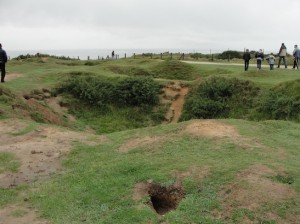 Next, we drove to the Paratroopers Museum at St. Mere Eglise. The paratroopers parachuted into areas around the Normandy beaches on June 5 in order to take out some of the German defenses.
Next, we drove to the Paratroopers Museum at St. Mere Eglise. The paratroopers parachuted into areas around the Normandy beaches on June 5 in order to take out some of the German defenses.
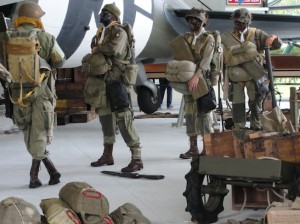 Some of the pilots were disoriented in the bad weather, so they dropped the men in the wrong place. One guy was caught on a church steeple in St. Mere Eglise! Germans shot at him as he hung there, so he pretended to be dead and eventually got down and escaped.
Some of the pilots were disoriented in the bad weather, so they dropped the men in the wrong place. One guy was caught on a church steeple in St. Mere Eglise! Germans shot at him as he hung there, so he pretended to be dead and eventually got down and escaped.
Our last stop of the day was Utah Beach, about a kilometer away from our campsite.
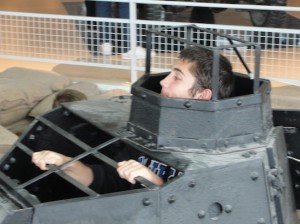 We explored the museum and then took lots of jumping pictures on the beach.
We explored the museum and then took lots of jumping pictures on the beach.
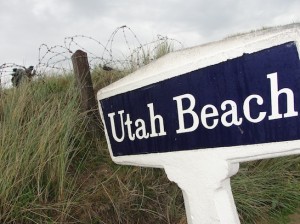
 After all the pictures were done, we walked back to camp. By then there was hot water for showers, but I had already given away my towel to a girl in my group who had forgotten hers, so I skipped yet another shower.
After all the pictures were done, we walked back to camp. By then there was hot water for showers, but I had already given away my towel to a girl in my group who had forgotten hers, so I skipped yet another shower.
That night we got a bit less sleep, but I still slept very soundly. There’s something about traveling with a bunch of teenagers that just exhausts me. I think it’s the constant noise of talking.
Sunday morning we woke up early (6am), packed everything up, ate breakfast, made lunches, loaded the bus, and drove to Paris. On the bus I sat with a group of kids and played Catch Phrase and Telephone Pictionary (the game where everyone starts with a blank piece of paper, writes a sentence, then passes the paper to the next person, then everyone draws a picture, then everyone writes a sentence based on the picture….). The noise is much more bearable if you’re a part of it. The bus drivers thought an alarm was going off when we were playing Catch Phrase! We also told a couple epic stories (each person says one sentence) about General Miner of Ugardistan (fictitious country), the Ottoman Empire, Nicolas Sarkozy, Gypsies, a giant Trojan Peach, a lady with 64 alien cats and 1 litter box, Wibbles the invisible jellyfish, Soviet nukes, and Gertrude Bell.
We got to Paris around 12:45pm. Our first stop there was the Louvre!
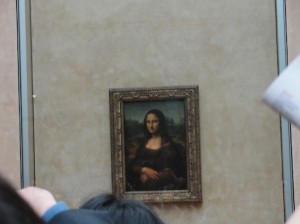 Though the Mona Lisa was the most famous piece there, my group was more excited about the Easter Island Head.
Though the Mona Lisa was the most famous piece there, my group was more excited about the Easter Island Head.
 My orchestra student H.J. wasn’t in the above picture, but here he is with a smiling sarcophagus:
My orchestra student H.J. wasn’t in the above picture, but here he is with a smiling sarcophagus:
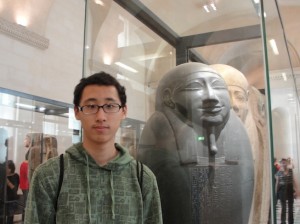 Next we walked to the Notre Dame cathedral.
Next we walked to the Notre Dame cathedral.
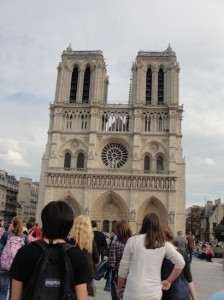 We had to take the metro to get to the Sacre-Coeur. Unfortunately, a couple pick-pocketers caught wind of our large group of students and made off with some money from 2 of our students. Fortunately it was not a huge amount, but the rest of the day everyone was really careful! Here’s a shot of me with one of the pick-pocket victims in front of the Sacre-Coeur:
We had to take the metro to get to the Sacre-Coeur. Unfortunately, a couple pick-pocketers caught wind of our large group of students and made off with some money from 2 of our students. Fortunately it was not a huge amount, but the rest of the day everyone was really careful! Here’s a shot of me with one of the pick-pocket victims in front of the Sacre-Coeur:
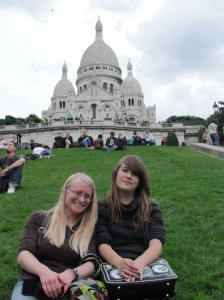 The next destination was the Arc de Triomphe. We had only a short metro ride with no pick-pocketing incidents. However, just as we came out of the metro, a group of hip-hop dancers invited us to a show. The kids loved it and the group loved how we created an instant crowd, but it took a bit of maneuvering to get the students away from the show and on to our destination!
The next destination was the Arc de Triomphe. We had only a short metro ride with no pick-pocketing incidents. However, just as we came out of the metro, a group of hip-hop dancers invited us to a show. The kids loved it and the group loved how we created an instant crowd, but it took a bit of maneuvering to get the students away from the show and on to our destination!
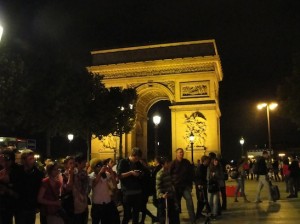 When Napoleon went around conquering cities, he kept a careful record. He decided to list all the names of the conquered cities on the Arc de Triomphe. One of those cities is right near Kandern!
When Napoleon went around conquering cities, he kept a careful record. He decided to list all the names of the conquered cities on the Arc de Triomphe. One of those cities is right near Kandern!
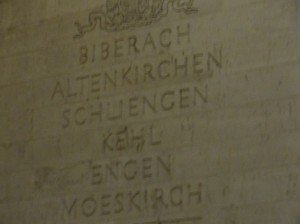 In the town of Schliengen, there is a building with a cannonball from Napoleon’s army.
In the town of Schliengen, there is a building with a cannonball from Napoleon’s army.
After watching the Eiffel Tower sparkle at 9pm from the top of the Arc de Triomphe, we explored the Champs-Elysees, ate dinner, then walked to the Eiffel Tower. We spent our time from midnight to 12:45 hanging out under the famous landmark of Paris.
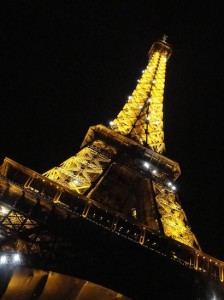 The kids amused themselves by playing Ninja. It’s a somewhat complicated game to explain, but simple enough to play. It requires fast reflexes!
The kids amused themselves by playing Ninja. It’s a somewhat complicated game to explain, but simple enough to play. It requires fast reflexes!
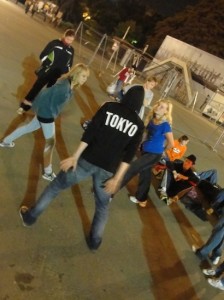 At 1am we were all on the bus and we headed home!
At 1am we were all on the bus and we headed home!
It was an exhausting trip, but well worth it. I got to know the Juniors better, and now I have some more ideas for our orchestra field trip to Paris next month!

